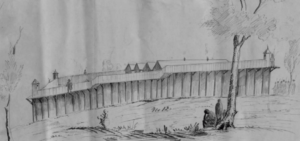During the Civil War, another war was waged north of here. In Southwestern Minnesota, the Sioux people, who previously were forced to leave their lands, returned to the area to fight in August 1862. This effort was led by Chief Little Crow (Ta-oya-te-duta) and a few of the warriors from his tribe.
At the time, Little Crow felt forced into a corner. Throughout the late 1850s, there was substantial friction between the for perceived slights on the men’s honor and abuse of women. The federal government also increasingly owed the Sioux more and more in annuity payments. When the payments came through, white traders who did business with the Sioux got the first claim on the funds, and any time there was a dispute over what was owed to the trader, the government sided with the white traders.
The payment delays caused severe hunger and hardship on the tribes. Little Crow’s disillusionment turned to anger. In response to pressure, Little Crow and a group of his warriors attacked hundreds of settlers, killing 358 settlers and forcing many more to flee.
The attack ended when soldiers captured hundreds of Dakota men, a subculture of the Sioux people, and interned their families after subsequent battles in New Ulm, MN, and at Birch Coulee. A military tribunal quickly tried the men and sentenced 303 of them to death. Fortunately, at the urging of several area clergy, President Abraham Lincoln reduced the sentences, but the mass hanging of 38 Dakota men was carried out on December 26, 1862. This was the largest mass execution in U.S. history.
By that same month, the Minnesota Volunteer Infantry had captured more than 1,600 Sioux, including women, children, and elderly men. After the mass hanging in Mankato, this group was forced to walk to Fort Snelling in Minneapolis. Many people on this long, horrifying walk thought they would be killed. Some, unfortunately, were after an angry group of Minnesotans attacked them.
After arriving at Fort Snelling, most learned they would be exiled from Minnesota to Nebraska and South Dakota. Throughout their captivity, another 200 people died at Fort Snelling because of poor conditions.
There is another side to this. After the initial hostilities against white settlers were committed, members of the Sioux tribe who were mostly involved with this insurrection fled to Canada. So, the “400 trials” conducted were people who were mostly innocent and the military had to create a scapegoat due to the crowds of angry Minnesotans. When these trials were conducted, they lasted minutes for each one. Very few of the Sioux spoke English and all had no one to defend them. They relied on missionaries to help translate. Of the 400 trials, 323 were convicted and 303 were given the death sentence. President Lincoln combed the list down to avoid European backlash. Of the 38 hanged, two were actually guilty of rape and one man was hanged due to the similarity of his name to another accused individual.
We need to note the Winnebagos were near Mankato, MN. So, they were also held accountable for these events, even though they had no association with Little Crow and his people. They were also expelled from Minnesota with the rest of the Sioux.


